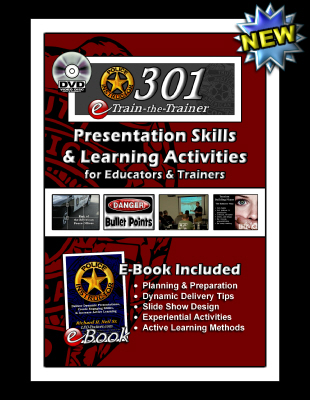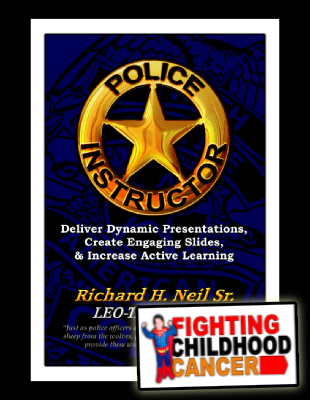I asked the group, “All right, who is up next?” There were no takers – just whiners. “I’m tired, someone else go…” “Tim and I are talking about something important, we’ll go next time…” and “I have to finish this text message…” These were all common responses from the cadets at a police academy I had just begun training for. I was so aggravated that I was planning each of their demises in my head, and it wasn’t a pretty picture.
I was helping another instructor with the second day of Traffic Stops & Approaches,  and I was shocked how unenthusiastic the cadets were. What was normally an interesting and interactive part of police training had now become a time of complacency that could result in later tragedy. The problem was in the way the training was being conducted by the instructor, who had decades of law enforcement experience, but was limited as an educator of cops. Ray knew how to perform a safe and effective traffic stop but not how to transfer his wisdom to cadets. A problem that every educator and trainer has faced at some point.
and I was shocked how unenthusiastic the cadets were. What was normally an interesting and interactive part of police training had now become a time of complacency that could result in later tragedy. The problem was in the way the training was being conducted by the instructor, who had decades of law enforcement experience, but was limited as an educator of cops. Ray knew how to perform a safe and effective traffic stop but not how to transfer his wisdom to cadets. A problem that every educator and trainer has faced at some point.
Jim lined two vehicles up in a common traffic stop scenario. He then played the part of the motorist, while one cadet acted
as the police officer conducting the stop, and the other 15 students sat around gossiping. And the longer they sat around, doing nothing, the harder it became to regain their attentiveness – or initiative. I knew there was a better way for us to teach and for them to learn. That desire began years of research to develop experiential learning methods for law enforcement training, and eventually lead to the creation of the Police Instructor handbook, as well as the activity below.
Cops & Robbers & Judges is a role-play method that requires your students to see a situation from several different perspectives, and gives them control of their own actions and decisions. The students take turns acting as police officers, perpetrators, and critics, while you merely act as a facilitator for the exercise. Like a football team, a huddle will follow each scenario, and that is where active learning and understanding will happen.
- “Regardless of what happens, a team controls its attitude, approach, and response.” ~Tony Dungy – Let your students know that law enforcement is a profession filled with people that make decisions and solve problems for a living, and they will need those skills during this exercise – regardless of what happens.
Begin by providing the class with a basic understanding of your topic through a lecture or demonstration of the proper tactics for the situation. After your initial training, have the students practice the skills as a team and continually work to develop new skills. As the coach, you must sit back and let the team run the plays. Your teaching and training will wait until half-time and after the game.
For this example, you are conducting a class on Stops & Approaches. After explaining and demonstrating the basics of a traffic stop to your class, you will need to develop their abilities to actually conduct a stop. You can accomplish this by presenting them with different scenarios. At first, have two students play the Cops, one play the Robber, and three act as the Judges. The Cops will initiate and conduct a traffic stop using the information you provided prior to the activity. The Robber should be given a basic scenario to follow, and provide your Judges with a checklist to observe and evaluate the Cops’ performance.
The Judges will concentrate on evaluating the scenario and not interact with the Cops or Robbers until the exercise is completed. Once finished, they can discuss which skills were performed well and which need improvement. The students will rotate their responsibilities and the new Cops will conduct the next traffic stop. Repetition is a key component to learning any new skill effectively, and you need to make sure they can perform their new skills correctly before you finish the training activity.
- “Never go to bed a loser.” ~George “Papa Bear” Halas – When pro football was just a fledgling enterprise Halas had the attitude and willpower to bring the team through the Great Depression and WWII. He demanded his players “get it right” before they left practice every day, and you can do the same when training cops and cadets.
Instead of only involving one student with the traffic stop (while the others sit around wasting training time), you will have everyone involved in the learning process. They will see the activity from several different points of view, and when they act as Judges, the students are constantly watching for mistakes; helping them to recognize their own and accelerate understanding. Next, comes the most valuable part of the activity – the huddle – where everyone speaks and everyone improves.
- “If you burn your neighbor’s house down, it doesn’t make your house look any better.” ~Lou Holtz – Make sure the conversations inside the huddle focus on improving skills and understanding – not undue criticism.
Whether we are talking about football or Cops, Robbers, & Judges, the huddle is a key element. Clarity comes from the huddle – not during the play. It will be after the scenario that the students huddle up and talk about what worked and what needs improved upon. When they are able to see the mistakes made by others, discuss them as a group, and then do it all again from a different perspective, they are performing at a much higher level of learning. While it is advantageous for you to be in the huddle, it is best to be a silent member unless it becomes necessary for you to speak. The more problems the students are able to solve for themselves the better. They are far more likely to understand and remember the information, and that shows them the value of working as a team. It is through the huddle that the team provides clarity, solves problems, creates a new vision, and develops unity.
- “Focus on your job—focus on what you do and do it right.” ~Bill Belichick – The New England Patriot’s unbelievable success has always come from their ability to keep players focused on individual responsibility to the team, instead of superstar moments that may lead to media fame. Develop the same focus and character in your students by using this technique, and others, that demand more from them than just listening.
You may find it helpful to start with an initial scenario or activity that is easy to perform and add more extensive situations as you move along, allowing your students to build a strong foundation for their new skills. Step in as the coach when needed but let the team play the game – much learning will occur. Cops & Robbers & Judges will also work with other hands-on training topics: Prisoner Booking & Handling, Domestic Violence, Active Shooter, and Building Searches are a few examples. Use your imagination and feel free to adapt the method to benefit your next training class.
“You can learn a line from a win and a book from a defeat.” ~Paul Brown
Richard H. Neil Sr. is the author of “Police Instructor: Deliver Dynamic Presentations, Create Engaging Slides, & Increase Active Learning.” He is a retired city cop, and instructs for several of Ohio’s criminal justice training academies. He can be contacted through his website that is dedicated to free resources for law enforcement educators and trainers – www.LEO-Trainer.com.











